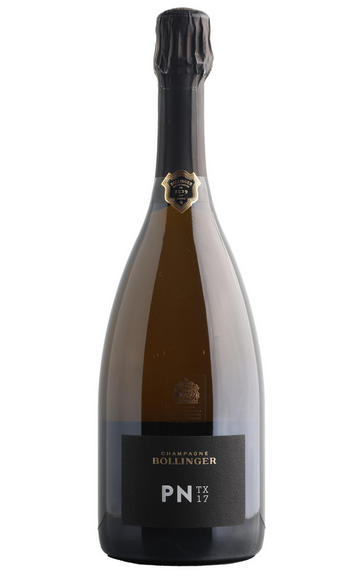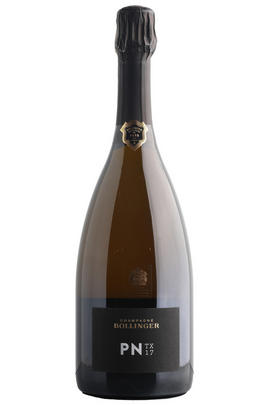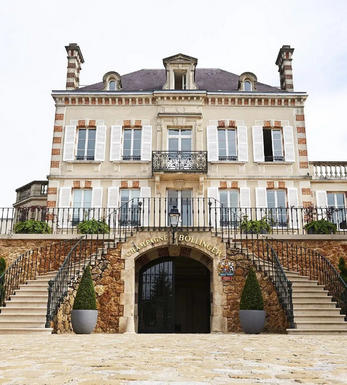
Champagne Bollinger, PN TX17, Brut

Critics reviews
From the commune of Tauxières and the 2017 vintage, Bollinger's new NV Brut Blanc de Noirs PN TX17 exhibits aromas of crisp pear, orange zest and wet stones mingled with subtle hints of warm bread and dried fruits. Medium to full-bodied, pillowy and fleshy, with tangy acids and impressive ripeness for the vintage, it concludes with an elegantly mordant finish. This doesn't strike me as a year built to make old bones, but it should nonetheless enjoy over a decade's evolution.
Drink 2021 - 2033
William Kelley, Wine Advocate (August 2022)
The wine is almost entirely dominated by the extremely exciting and rare Tauxières Premier Cru, one of two villages classified 99% on the Grand Cru scale. Despite an impressive vineyard area of 237 hectares, it is extremely rare to see champagnes dominated by this fantastic Cru.
A cooler microclimate and a thinner soil layer with even more compact chalk than sunny Bouzy make the wines from here lighter and more elegant than Bouzy but stronger than Verzenay, which is also part of this exciting Blanc de Noirs with a predominantly base from 2017.
Here is also a tiny splash of Avenay to give a bit of buttery roundness to the cuvée with its low dosage of 4 grams. The reserve wines from magnum bottles under low pressure make up 48% of three vintages in 2016, 2009 and 2006. Half of the wine is made in oak barrels, and the other half in steel tanks. The result is lovely and personal.
The scent has features of lead pencil, juniper and freshly lacquered boat, and more classic coffee notes, rose petals, apricot and peach. The taste is vivid and multifaceted with lively precision and lighter fruit aromas than you usually find in Bollinger’s wines. Even cassis is one of the more unexpected aromas in this finely tuned complex symphony.
Very impressive and exciting Champagne makes me want to taste more and look out for my private cellar.
Richard Juhlin (June 2022)
About this WINE

Bollinger
The Champagne House of Bollinger was established in 1829 by Jacques Bollinger and Paul Renaudin. Over the years the vineyard holdings have been steadily increased with the largest expansion taking place under the stewardship of the legendary Mme Lily Bollinger. She ran the company between 1941 and 1977 and today it is managed by her great-nephew, Ghislain de Montgolfier.
Bollinger has a reputation for producing muscular champagnes with body, depth and power, and is today considered one of the "Great" Champagne houses.
70% of the grapes come from the firm's own vineyards. 80% of the harvest is barrel-fermented with the wines being kept on their yeast lees for an extended period of time (in the case of the RD, around 10 years).
Bollinger produces classic, complex, Pinot-Noir dominated champagnes with the ability to age gracefully for many years.

Brut Champagne
Brut denotes a dry style of Champagne (less than 15 grams per litre). Most Champagne is non-vintage, produced from a blend from different years. The non-vintage blend is always based predominately on wines made from the current harvest, enriched with aged wines (their proportion and age varies by brand) from earlier harvests, which impart an additional level of complexity to the end wine. Champagnes from a single vintage are labelled with the year reference and with the description Millésimé.
Non-vintage Champagnes can improve with short-term ageing (typically two to three years), while vintages can develop over much longer periods (five to 30 years). The most exquisite and often top-priced expression of a house’s style is referred to as Prestige Cuvée. Famous examples include Louis Roederer's Cristal, Moët & Chandon's Dom Pérignon, and Pol Roger's Cuvée Sir Winston Churchill.
Recommended Producers : Krug, Billecart Salmon, Pol Roger, Bollinger, Salon, Gosset, Pierre Péters, Ruinart

Pinot Noir
Pinot Noir is probably the most frustrating, and at times infuriating, wine grape in the world. However when it is successful, it can produce some of the most sublime wines known to man. This thin-skinned grape which grows in small, tight bunches performs well on well-drained, deepish limestone based subsoils as are found on Burgundy's Côte d'Or.
Pinot Noir is more susceptible than other varieties to over cropping - concentration and varietal character disappear rapidly if yields are excessive and yields as little as 25hl/ha are the norm for some climats of the Côte d`Or.
Because of the thinness of the skins, Pinot Noir wines are lighter in colour, body and tannins. However the best wines have grip, complexity and an intensity of fruit seldom found in wine from other grapes. Young Pinot Noir can smell almost sweet, redolent with freshly crushed raspberries, cherries and redcurrants. When mature, the best wines develop a sensuous, silky mouth feel with the fruit flavours deepening and gamey "sous-bois" nuances emerging.
The best examples are still found in Burgundy, although Pinot Noir`s key role in Champagne should not be forgotten. It is grown throughout the world with notable success in the Carneros and Russian River Valley districts of California, and the Martinborough and Central Otago regions of New Zealand.


Buying options
Add to wishlist
Description
Exciting and uplifting, Bollinger's PN TX17 is a pleasure to enjoy. Juicy flat peaches, summer pudding and zesty red grapefruit leap from the glass and complexity reaches each tastebud with toasted almond croissants and buttered shortbread. The fine mousse dances across your palate with just a kiss of seaside air. Sublime now, how it will evolve through time in the cellar is thrilling.
Drink now to 2031
Amy Johnson, Account Manager, Berry Bros. & Rudd (June 2023)
wine at a glance
Delivery and quality guarantee